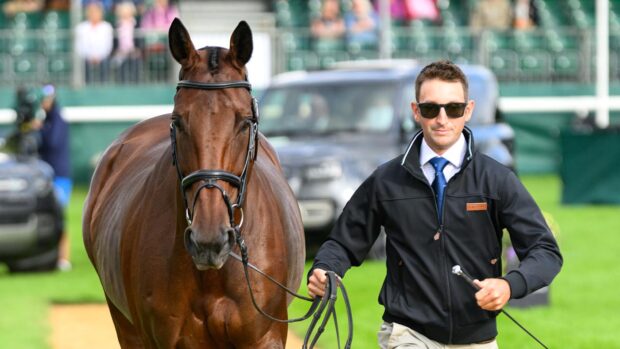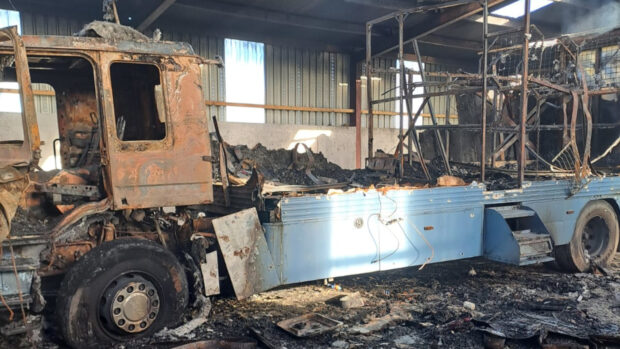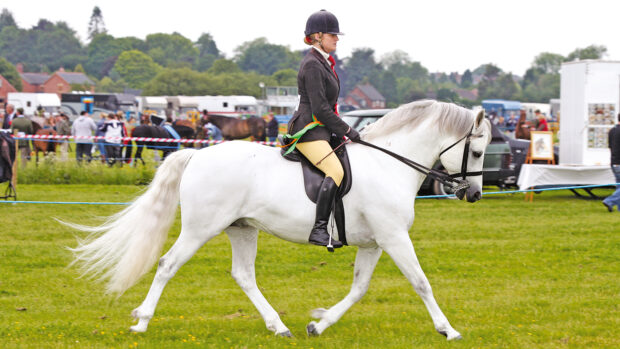At the weekend I had a really constructive lesson with Damian Hallam on young “Fly”, who I started for Hazelhope Stud last year. It was marred only by the most torrential storm halfway through with horizontal rain that soaked us in an covered arena! Fly was such a star — the rain, thunder and lightening did not put her off and she produced some lovely work (see video below).
It was also great to hear Damian is really happy with his 4-year-old gelding, Solento, who I started a few months ago. Although it is difficult to fit training in for myself, these sessions are so beneficial for me, as has been spending time with professionals from other equestrian spheres, such as performance psychologist, Charlie Unwin. My wife always rolls her eyes when I say I’m meeting him as she knows we’ll stay up chewing the fat for hours!
Although he may not realise it, what Damian says in our lessons and the exercises I do, not only resonates with training for dressage, but in all my work with young and remedial horses. In this lesson we were working on maintaining rhythm and balance without losing her softness, something that is applicable to all disciplines. However, it is also key to solving many ridden problems, including rearing.
I tend to get ‘runs’ of horses with similar behavioural problems. Whether it is just coincidence, or rather that I am gaining a reputation of helping with this type of problem, I am handling an increasing number of dressage horses that have started to develop, or have an ingrained, rearing problem.
Rearing can be an extremely dangerous and unnerving habit. My take on why horses start to rear is this — although there are different circumstances under which a horse will start rearing, the common denominator is usually a “block” at the poll junction. When energy is then put in, either by the rider pushing the horse forward or from the horse’s own excess energy, the horse has nowhere to go but up.
The block is usually caused by riders bracing themselves against the bit in order to force an “outline”, or through apprehension or inexperience. Horses’ mouths are highly sensitive so can only resist against the bit so much, therefore the majority of the resistance comes at the poll junction, which then creates tension and resistance throughout the horse’s body (imagine you got a fright, what does your body do?).
If the horse is made to go forward into this and they find no release from the hand, they will find it very difficult. This will eventually cause them to drop behind the rider’s leg. A common rider error when the horse does this is to push forward more. This will create a claustrophobic, and therefore irrational, horse that will look to rearing or other unwanted behaviours. This is why it is so important to recognise any softness and “try” from the horse by relaxing/giving our hand when he responds to our aids.
Of course, rearing is not a “dressage problem”, but sometimes to much focus on the outline can overshadow the need for a supple, relaxed way of going before stepping up the contact and collection. There is a big difference between a horse that is collected and taking the rider forward, but can still flex laterally at the poll, to one that looks collected, but is tense and “set” at the poll.
“Hot” horses that get excited can also start rearing if they are held still. They come behind the bridle and need an outlet for their energy. In this case, the rider needs to direct the horse into a circle and create movement to release the energy and get them following the contact, not hiding from it.
Rearing when napping is also common, but the reason behind this is a little different. It is caused by a lack of leadership or respect for the rider. The block though the body is there, but is caused by the same natural instinct that a horse would have after it has been caught by a predator. He doesn’t want to be moved so will brace himself and plant his feet. In this situation the horse may give you one, or maybe a couple of attempts at stepping forward and it is essential to stop asking at even the smallest attempt to step forward so he feels rewarded.
I would love to hear readers’ thoughts about this. I put a post on my facebook page about it and got some really interesting stories in response. Join in the debate there or below this article.
On the rest of the work front, things are a quite hectic with horses in on training and very busy clinics, but Tom is hoping to be back to work in March after his car accident, which will be a great relief!
But no matter how tired I am after the day, I am always coerced into some kind of activity with the kids, be it football, gymnastics or some bad “Dad-dancing”! My kids never fail to amaze me – Jack (8) suddenly decided to perform backflips on the living room floor and Rosie (5) has now perfected her splits… I wish I had a 10th of their flexibility, it would make getting on those giant dressage horses a little easier!
Jason




